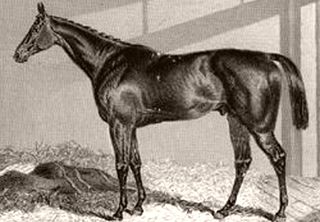
Thoroughbred horse racing is an important spectator sport in Australia, and gambling on horse races is a very popular pastime with A$14.3 billion wagered in 2009/10 with bookmakers and the Totalisator Agency Board (TAB). The two forms of Thoroughbred horseracing in Australia are flat racing, and races over fences or hurdles in Victoria and South Australia. Thoroughbred racing is the third most attended spectator sport in Australia, behind Australian rules football and rugby league, with almost two million admissions to 360 registered racecourses throughout Australia in 2009/10. Horseracing commenced soon after European settlement, and is now well-appointed with automatic totalizators, starting gates and photo finish cameras on nearly all Australian racecourses.

Eclipse was an undefeated 18th-century British Thoroughbred racehorse who won 18 races, including 11 King's Plates. He raced before the introduction of the British Classic Races, at a time when four-mile heat racing was the norm. He was considered the greatest racehorse of his time and the expression, "Eclipse first, the rest nowhere" entered the English vernacular as an expression of dominance.

Carbine (1885–1914) was a champion New Zealand-bred Thoroughbred racehorse who won 30 principal races in New Zealand and Australia. He was very popular with racing fans, and sporting commentators of the day praised him for his gameness, versatility, stamina and weight-carrying ability, as well as for his speed. He was one of five inaugural inductees into both the New Zealand Racing Hall of Fame and the Australian Racing Hall of Fame.

Sir Hercules (1826–1855) was an Irish-bred Thoroughbred racehorse, and was later a successful sire.

Stockwell (1849–1870) was a British Thoroughbred racehorse and a Leading sire in Great Britain & Ireland seven times; he was second on the sires' list a further four times during a 14-year period.

Dark Ronald was an English bred Thoroughbred racehorse and sire with a global influence on the breeding of Thoroughbreds and sport horses, with many show jumpers tracing back to him.
Danzig was an American Thoroughbred racehorse who is best known as a leading sire. He was purchased for $310,000 by Henryk de Kwiatkowski at the 1978 Saratoga Yearling Sale. The son of Hall of Famer Northern Dancer and the most commercially successful sire of the second half of the 20th century, he won all three of his races before knee problems ended his racing career.
Vaguely Noble (1965–1989) was an Irish-bred Thoroughbred racehorse who competed in the United Kingdom and France. The colt is best known as the winner of the 1968 Group One Prix de l'Arc de Triomphe when he defeated the best horses from England, France, Ireland and Italy. He was later a leading sire in Great Britain & Ireland and a Leading broodmare sire in GB & Ireland. Vaguely Noble is one of the highest-rated horses ever to run in Europe.
Street Cry was a Thoroughbred racehorse, winner of the 2002 Dubai World Cup, the 2002 Stephen Foster Handicap and runner up in the 2002 Whitney Handicap. He was an international shuttle stallion that stood at the Darley Studs in Australia and the US.

Chester (1874–1888) was an Australian thoroughbred racehorse and a leading sire. He defeated some of the best horses in training over distances ranging from five furlongs to three miles. He was the leading sire in Australia on four occasions.

Thoroughbred breeding theories are used by horse breeders in an attempt to arrange matings that produce progeny successful in horse racing. Bloodstock experts also rely on these theories when purchasing young horses or breeding stock. A basic understanding of these theories can also help the racing public understand a horse's theoretical genetic potential. The breeding theories stem from the belief that careful analysis of bloodlines can lend predictability to breeding outcomes. A well-designed mating increases the probability of the offspring's success, although many other factors also come into play.

The Thoroughbred is a horse breed best known for its use in horse racing. Although the word thoroughbred is sometimes used to refer to any breed of purebred horse, it technically refers only to the Thoroughbred breed. Thoroughbreds are considered "hot-blooded" horses that are known for their agility, speed, and spirit.

Court Martial was a Thoroughbred racehorse bred and raced by Lord Astor best known for defeating two exceptional colts in Dante and Royal Charger for the Classic 2000 Guineas Stakes and as a two-time leading sire in Great Britain and Ireland.

Nereide was an undefeated Thoroughbred racemare that won the 1936 German Derby and the 1936 German Oaks.

Encosta De Lago was an Australian bred Thoroughbred racehorse that won three group races from eight starts including the Group One (G1), Vic Health Cup against older horses. He was the Leading sire in Australia during 2008 and 2009.
Algerine was an American Thoroughbred racehorse that won the 1876 Belmont Stakes and was the maternal grandsire of Rhoda B, the dam of the 1907 Epsom Derby winner Orby.

Sweetmeat was a successful English Thoroughbred racehorse that won 16 consecutive races as a three-year-old, including the Doncaster Gold Cup, and was a useful sire of the early 19th century.
Noble was a British Thoroughbred racehorse and sire. In a career that lasted from May 1786 to May 1788 he ran at least three times and won two races. He won the seventh running of The Derby as a 30/1 outsider in what was probably his first race. His only other success came at Newmarket later that year. He was retired to stud where he stood as a stallion for several years but made little impact as a sire of winners.

Cobweb (1821–1848) was an undefeated British Thoroughbred racehorse and who won two British Classic Races as a three-year-old and went on to become a highly successful broodmare. Cobweb's racing career consisted of three competitive races in the early part of 1824. After winning on her debut she claimed a second prize when her opponents were withdrawn by their owners. She then won the 1000 Guineas at Newmarket Racecourse and the Oaks Stakes at Epsom Downs Racecourse before being retired to stud.
Street Boss is an American Thoroughbred racehorse that won the 2008 Triple Bend Handicap and Bing Crosby Handicap. He stands as a shuttle stallion for Darley Stud, the global breeding operation of Godolphin.














